Termites cause billions of dollars worth of property damage in the United States each year, and property damage caused by termites is rarely covered by homeowners insurance. An active termite infestation poses an ongoing threat to properties, emphasizing the need for vigilance. The best way to protect your home from termites is prevention, but the next best way is early detection. Below, we’ll point out some early warning signs of termites, so you can identify termite infestation signs and treat a termite problem before too much damage is done.
Commercial and Residential Pest Control Services | Dodson Bros. Exterminating Co., Inc.
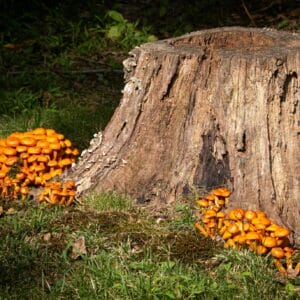
Termites on your property outside
Maybe you haven’t found termites in your home yet, but don’t be deceived — they could still be nearby in your yard. If you have trees, stumps, outbuildings, or wood piles on your property, check them regularly for termite damage.
Signs of termites include the termites themselves and mud tubes or round tunnels chewed through wood. Subterranean termites are particularly notorious for building mud tubes as a means to travel and are responsible for a significant amount of damage to residential homes due to their underground nesting habits.
Once a termite colony has taken up residence near your home, it’s only a matter of time before termite swarmers take flight and land on your home. Drywood termites are known to nest directly inside wood, making their presence less obvious until significant damage has occurred. When a termite colony reaches a certain size, the winged swarmers will take flight to find a new food source and shelter in which to start a new colony. Swarmers don’t typically travel very far from the original colony, so if there is a growing colony on your property, your house might be their next target.
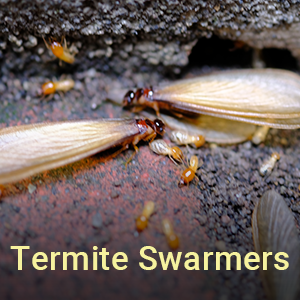
Swarmers (and their wings)
As we mentioned earlier, termites will periodically send winged swarmers out of the colony to find new food sources.Once swarmers land on a suitable structure for their new colony, they will shed their wings and get to work building their new population.
These flying insects are tiny — and can be difficult to discern from flying ants — but they travel in large, easy-to-spot termite swarms. Swarmers — also called alates — are most active in the spring, but they can strike at any time. If you don’t have an active termite colony in your house, swarmers will likely be the first to arrive.
If you see a cloud of tiny flying insects, or piles of termite wings on window sills, near door frames, or around your home, it might be time to consult a professional. Discarded termite wings can often be found in spider webs, on surfaces around the home’s foundation, or near other entry points, serving as an early warning sign of termite activity. It may take a couple of years for their new colony to reach maturity, but your home will already be severely damaged by then.
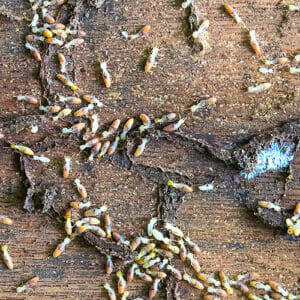
Mud tubes
Mud tubes are small tunnels and columns of dirt that termites build so they can safely travel above ground without being spotted by predators or harmed by the elements. Termites often build these mud tubes up along walls, tree trunks, and other protrusions from the ground.
If you see mud tubes along the side of your house’s foundation, call a pest control technician for a termite inspection immediately. They’re a sure sign termites have already found your house and invested their energy into infrastructure so they can visit it again and again — eating a little bit more each time.
Mud tubes are not limited to the side of your house, however — they can be built just about anywhere. Termites can build these mud tunnels behind drywall, or even spanning the space between a house’s subfloor and its dirt basement or crawl space floor. These “drop tubes” are built like stalactites and allow termites to travel directly from their underground colony up into your home.
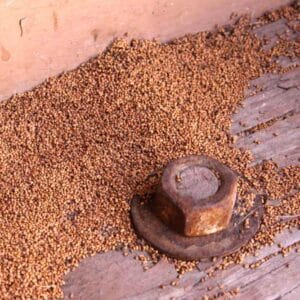
Termite droppings
Termites do an excellent job managing the waste of their vast, densely populated colonies. Worker termites regularly collect feces (called “frass”) in the colony and push them out of “kick-out holes,” which are similar to a trash chute in a large apartment building.
Because this waste is collected and dropped out of a small hole regularly, you might find small piles of what looks like sawdust or coffee grounds around your property — especially inside of structures where the pellets aren’t disturbed by wind and rain. Discovering these termite droppings is a common sign of termite infestations, highlighting the need for vigilance in detecting and addressing these hidden threats.
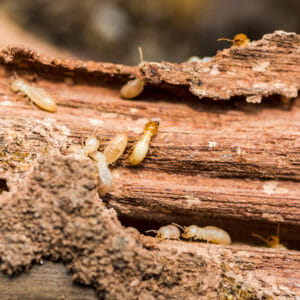
Favorable conditions
If you don’t see any signs of termites in your home, that’s great! But termites can appear in your home — seemingly out of nowhere, thanks to their enormous subterranean networks — at any time.
Don’t wait until you know there are termites in your home to take action. Take stock of conditions in and around your property and do what you can to protect yourself and your home. Termites eat various types of wood, especially favoring damp, rotting, or untreated wood, which provides them with both nourishment and moisture.
Termites prefer moist and rotten wood as it’s easier to chew through and can provide the colony with water. Similarly, they are attracted to homes with moist basements or plumbing leaks. Termites will typically begin to swarm in the spring, when their population is more active and growing. They love wooded areas and properties with large wooden structures — houses, barns, sheds, etc.
While favorable conditions alone don’t necessarily require a call to your local pest control professionals, if your property meets these criteria, it’s best to be diligent with regular inspections.
Don’t wait until it’s too late — schedule a free inspection
A termite infestation can wreak havoc quickly, so take action before they are established in your home. Professional termite treatment from Dodson Pest Control offers effective solutions for addressing active infestations, implementing preventative measures, and providing options suited to your specific needs. If you don’t see signs of these pests in or around your property, call Dodson Pest Control for a free termite inspection and defensive treatments.
Our trained pest control inspectors will thoroughly examine your property to determine if termites are present and then build a customized termite control plan with pesticides tailored to your particular needs. Liquid insecticide can then be applied to the soil beneath concrete floors and/or along the entire perimeter of your property’s foundation to treat for termites and provide a protective barrier. The product is safe for children and pets, both interior and exterior, but will effectively kill termites.
Subterranean termite treatments are designed for homes and businesses who want to take proactive measures to preserve their property, especially in areas where termites are considered a major threat, or where conditions are favorable for termite colonies to thrive.
Do you want to protect your home against termite damage? Let us take care of it.
